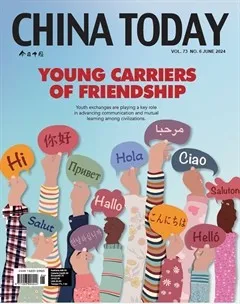Economic Coercion Inhibits Sustainable Global Growth
Zhang Hui
The Biden administrations tariff hikes on Chinese products came,unsurprisingly, a month or so before the first 2024 presidential debatebetween incumbent U.S. President Joe Biden and former PresidentDonald Trump. They are thus preparing to play the China card oncemore. Biden has announced tariff increases across key sectors, purportedlyto “protect American workers and businesses from Chinasunfair trade practices,” according to the White House. The WhiteHouse Fact Sheet also emphasizes the Biden administrations creationof jobs in key sectors, as a countermeasure to the Trump administrationsfailed China strategy to increase American exports and boostAmerican manufacturing. The administrations political agenda is thuslaid bare.
"U.S. politicians are using trade bullying policies as presidentialcampaign bids with an attempt to secure support from some laborunions," said Mei Xinyu, a researcher with the Chinese Academy ofInternational Trade and Economic Cooperation, in an interview withXinhua.
Calling the move "a clear example of political manipulation," aspokesperson for the Ministry of Commerce noted that the UnitedStates has politicized and used trade issues as a tool.
The tariff hikes on Chinese products, which amount to blatant protectionismand economic coercion, belie the U.S. image as a championof open economy and free trade, instead highlighting its hegemonicmindset.
Having investigated the negative impact of unilateral sanctionsimposed on China through relentless U.S. pressure on Chinese techcompanies since 2017, the UN Special Rapporteur on unilateral coercivemeasures and human rights Alena Douhan called on the U.S. tolift sanctions on China on May 17 during her visit to Beijing. Moreover,Douhan urged states to take strong action to curb sanction over-complianceby businesses and other actors under their jurisdiction. TheUN Special Rapporteur deplored the decline in business activities thatsanctions had caused, and how the consequent loss of global marketshad affected those most vulnerable, “including women, older persons,and all those in informal employment.”
The recent U.S. move will increase tariffs on Chinese EV importsto 100 percent, those on solar cells to 50 percent, those on steel andaluminum products to 25 percent, and those on semiconductors to 50percent, by 2025.
The potential disruption of global supply chains and normal productionthese measures threaten will also harm the U.S. economy. "Theadditional tariffs will drive up commodity prices in the United States,which will end up dampening consumer spending and exacerbatinginflations," said Zhang Jun, chief economist with China Galaxy Securi-ties, in an interview with Xinhua.
Additional tariffs slapped on Chinas key sectors, notably new-energyvehicles (NEV), also signify, certain experts observe, the U.S.s hiddenagenda to curb the development of Chinas emerging industries in a bidto maintain its dominant position in the global industrial chain.
China is rising as a global leader in the new energy sector by meritof the countrys strategic foresight and unremitting efforts to advancegreen development. Having been a bellwether in the NEV industry fornine consecutive years, in 2023 China saw both its production andsales exceed nine million units. Meanwhile, as a key driver of globalgreen transformation in the automotive industry, Chinas NEV exportssoared 77.6 percent in 2023, reaching 1.203 million units. The 278 newenergymodels that made their debut at the 2024 Beijing InternationalAutomotive Exhibition underlined the magnetism of the Chinesemarket and the robust growth of the countrys new energy sector. Aworkable and effective national strategy, along with technological innovation,have helped to fuel the green trend.
The global popularity of Chinas NEVs is attributable to theircomparative advantages in market competition of being driven byinnovation, rather than spurred by subsidies. The rhetoric of overcapacity,moreover, does not hold water in view of China's NEV exportsconstituting only a small portion of its total production – 12 percentlast year.
That a countrys production capacity outstrips its domestic demandis not uncommon in a market economy, and also a result of comparativeadvantages and labor division. "For instance, 80 percent of U.S.-manufactured chips are exported, 50 percent of Japanese cars are soldoverseas, and nearly 80 percent of Germany's auto output is shipped toforeign markets," Ding Weishun, a Ministry of Commerce official, saidrecently.
As the threat of climate change continues to looms large, dealingwith it becomes ever more urgent. Amid the global effort forsustainable growth, the demand for new energy products is surging.Chinas thriving new energy sector helps to advance the globaldrive. The U.S. unilateral tariff measure, however, is inhibiting theglobal effort.
In fact, the worlds two largest economies share considerable cooperationopportunities in sustainable and inclusive development. Thisis potentially beneficial for both countries, and may also contribute tothe well-being of the entire planet, Noah Fraser, senior vice presidentof China operations with the U.S.-China Business Council, observedat a recent forum. The joint efforts of both countries will undoubtedlypromote the global drive towards sustainable green development, butthe tariff scheme is putting a brake on the process.

